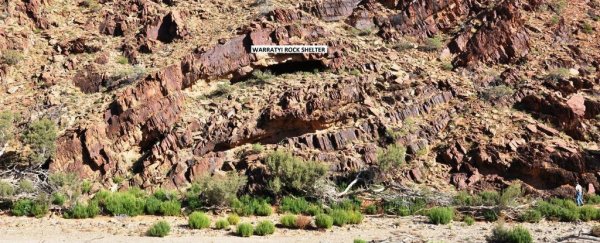Humans arrived in the arid interior of Australia some 10,000 years earlier than we thought, archaeologists suggest, with the discovery of ancient artefacts in a South Australian cave that have been dated to as far back as 49,000 years ago.
That means once humans first set foot on the Australian coastline, it took a mere 1,000 years for them to expand out into its dry interior - further evidence of the ingenuity of what now stands as the oldest continuous civilisation on Earth.
The site, which is a newly discovered cave in the Flinders Ranges, about 550 km north of Adelaide, is known as the Warratyi rock-shelter.
Archaeologist Giles Hamm from La Trobe University in Melbourne led the excavations at the cave, finding what appear to be some of the oldest bone and quartz tools ever found in Australia, plus the earliest known use of the pigment ochre in the country's history.
Artefacts that have been found so far include burnt eggshells, sharpened stone and bone tools, red ochre and gypsum pigments, and the team says this is evidence that these early technologies were developed locally.
"The old idea is that people might have come from the East, from the Levant, out of Africa, and these modern humans may have come with a package of innovative technologies," Hamm told Nicola Davis at The Guardian.
"But the development of these fine stone tools, the bone technology, we think that happened as a local innovation, due to a local cultural evolution."
That's significant, adds one of the team, Gavin Prideaux from Flinders University in Adelaide, because it challenges certain assumptions that Indigenous Australians were not as innovative as similar populations elsewhere in on the globe.
"There is a Eurocentric view that material culture in Australia is quite simplistic and backward, but this helps rewrite that story," he told ABC News.
Until now, the oldest human tool found in Australia's vast, arid interior has been a tiny axe fragment found earlier this year in the Carpenter's Gap rock-shelter of the Kimberley region of northwest Australia.
While the Carpenter's Gap site is not far from the northwest coast of Australia - thought to be one of the earliest settled parts of Australia - the Warratyi rock-shelter sits more than 2,000 km from the early settlement of Lake Mungo in southeasten New South Wales, making it a much more difficult trek.
The tools have been dated based on a couple of estimates - quartz grains from the site have been dated to 44,000 years ago, but radiocarbon dating of the burnt eggshells, which are thought to be evidence of human cooking, revealed them to be between 45,000 and 49,000 years old.
The shells are thought to have come from emus and a large, extinct flightless bird from the Genyornis genus. Together with discovery of bones of a huge, extinct wombat-like species, Diprotodon optatum, this suggests that early humans were actually interacting with Australia's legendary megafauna.
 Diprotodon reconstruction. Credit: Dmitry Bogdanov/Wikimedia
Diprotodon reconstruction. Credit: Dmitry Bogdanov/Wikimedia
This doesn't necessarily mean they were hunting them, but they were at least living in close enough quarters that they could find bones and eggs and bring them back to the cave.
"One good thing about this study … is there's no doubt there are megafauna remains in the form of Diprotodon and a giant bird in that rock shelter in a well-dated, well-stratified context sometime between 45,000 and 50,000 years ago," Prideaux told the ABC.
"The only way those bones and shells got there is because people brought them there … in terms of megafauna that's the really significant finding."
The find is, of course, controversial, because that tiny axe fragment we mentioned earlier has been dated to around the same time period - 44,000 to 49,000 years ago. The problem is these estimates are all fairly rough, and still up for interpretation - Hamm's team, for example, insists that the axe is no more than 48,000 years old.
"[E]veryone is keen to make their site sound older," Sue O'Connor from the Australian National University, who was not involved in either find, told Marcus Strom at The Sydney Morning Herald. But she did add that "the Hamm discovery was likely older".
"The methodology of this study is as good as it gets," she said. "It's a very important site and a really significant find."
Debate will likely rage among archaeologists for some time, but the most important thing is that we're finally seeing real evidence of just how widespread the Indigenous Australians were within just 1,000 years of hitting the coast.
The study has been published in Nature.
